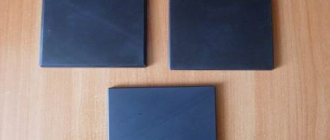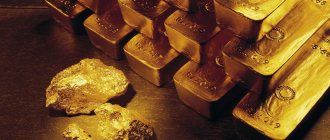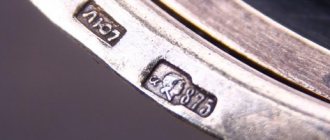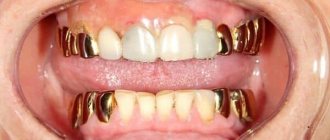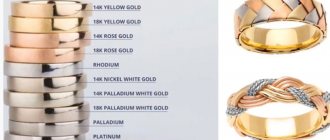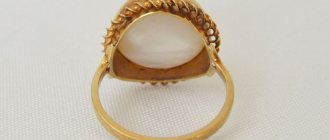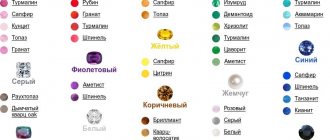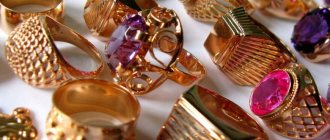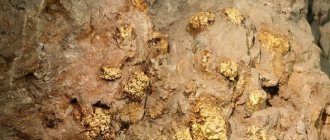Unfortunately, even when buying gold in expensive stores with a good reputation, it is not possible to be 100% sure of its quality. There are many ways to test gold that can be done at home, but they are all unreliable and cannot be completely relied on. In a workshop setting, a gold reagent is used for testing.
Testing gold with a reagent
Stages of gold testing
Each product made of precious metal that is imported or sold through retail chains is subject to testing. The process is controlled by the government Assay Office. The jewelry is stamped with a mark that indicates the percentage of gold in the alloy. For example, 750 standard indicates that the noble metal contains 75%, 585 standard indicates 58.5%, etc. For convenience and systematization of branding, state sample systems have been developed, the most famous of which are metric and carat. The latter is used in Western countries.
The process of testing gold products consists of several stages.
- Visual inspection of the product. Particular attention is paid to the quality of the mark, its clarity, evenness of lines and legibility. On fakes, the sample has an uneven structure, numbers and letters are difficult to see. In addition, careful examination of the symbols will help identify gilding or jewelry. A specialist, upon visual inspection of the jewelry, can easily determine its quality and whether it belongs to a particular group of alloys.
- Cleaning the product. With the permission of the owner, part of the surface of the jewelry is cleaned before testing. This is necessary to confirm that the item being tested is truly gold and not gilded. During work, needle files, finely cut files and a tool for precise processing of the surfaces of metal products - a scraper - are used. The procedure is performed from the inside of the product, as carefully as possible and away from the assay mark.
- Application of the reagent. After preliminary determination of the sample, a reagent is applied to the stripped part of the decoration in a vertical position. The drop should not spread. An important point is the exposure time of the assay material on the surface. It varies depending on the type of reagent and sample. Acids on metal with marks 375, 500 and 585 are kept for 5-10 s, and with mark 750 - 20 s. Gold chloride should be on the surface for 7-12 s, potassium iodide - no more than 5 s. Failure to comply with the time intervals will lead to distortion of the characteristic chemical reaction. At the end of the procedure, a drop of the reagent is removed with a napkin or piece of calico.
Applying a reagent to gold
Testing jewelry is accompanied by characteristic reactions, according to which the alloy sample is determined. The procedure is relevant for products on which the mark has worn off and is difficult to see.
Lugol's solution
In fact, iodine (common iodine I2) is insoluble in water. Let’s dissolve its complex with potassium iodide. This compound is called Lugol's solution - and it can dissolve gold. By the way, it is often used to lubricate the throat of those with a sore throat, so not everything is so simple.
This reaction also occurs through the formation of complexes. Gold forms complex anions with iodine. It is used, as a rule, for etching gold - a process in which interaction occurs only with the surface of the metal. Lugol's solution is convenient in this case because, unlike aqua regia and cyanide, the reaction is noticeably slower (and the reagents are more accessible).
Types of reagents and their effect on gold alloys
Testing of gold jewelry is carried out using several types of reagents. Each of them is used for a specific alloy and has a characteristic effect on it.
Chlorine gold
Gold chloride is a reagent used for testing jewelry without specifying samples. Thus, you can find out whether the alloy being tested contains precious metal and in what quantity.
Gold chloride is suitable for detecting counterfeits. With its help you can distinguish real gold from gilding and costume jewelry. In addition, the reagent is applicable for white precious metal 500, 583/585.
When choosing a chemical for testing jewelry, you need to know that it only works on alloys with a gold content of up to 60%.
Acidic reagents
Acid compounds for testing precious metals are a mixture of nitric and hydrochloric acids in various proportions. Distilled water is added to them. For example:
- nitric acid density 1.5;
- hydrochloric acid, density 1.20;
- distilled water.
The amount of reagents directly depends on the samples of the alloys being studied.
The effect of acid reagents on gold is of two types. On some products they leave a light stain, on others they do not have any reaction. The chemical element does not affect high-grade alloys or leaves dark marks on them.
Each acid reagent corresponds to a specific sample for analysis: 375, 750, etc. The lower the gold content in the alloy, the more pronounced the color of the reagent stain.
Acidic reagents for gold determination
When testing gold alloys of 375, 500, 750 standard, acid-containing preparations leave a transparent drop on the cleaned area without any trace. In rare cases, a subtle light shadow appears.
If the reagent is dropped onto a product made of base metal, a certain reaction will begin on its surface, followed by bubbling and the appearance of a greenish precipitate. A specific unpleasant odor will also appear.
Potassium iodide solution
The product is used to test alloys with a high content of precious metals. This chemical is used to detect counterfeit metals that are resistant to other reagents. The reagent with a solution of potassium iodide does not work on alloys whose fineness starts from 900. On a product with a mark of 800 and on jewelry with high chemical resistance, a black or green spot will form with possible subsequent bubbling.
Crystal lattice:
| 300 | Crystal cell |
| 311 | Crystal grid #1 |
| 312 | Lattice structure |
| 313 | Lattice parameters |
| 314 | c/a ratio |
| 315 | Debye temperature |
| 316 | Name of space symmetry group |
| 317 | Symmetry space group number |
Method of using reagents
Reagents for gold can quite accurately determine their sample; they are convenient to use on a large scale, and not at home. Their use for testing begins with inspection of the product. Sometimes one glance at a sample is enough to identify a fake. The mark may contain asymmetrical symbols, curved shapes and images. The next step is to determine whether the alloy belongs to the group of low-grade or high-grade gold.
The surface of the product in a certain place is cleaned. This helps to find out if there is another metal underneath the gold layer or if it is a single alloy. The further procedure depends on the type of reagent chosen.
Gold chloride does not act equally on different compositions. To check the purity, the reagent is applied to the surface of the jewelry. Alloys from 585 to 999 samples will not react in any way to the chemical compound. On products that contain half of the total mass of precious metal, gold chloride will leave a dark stain. If the material has a negligible yellow metal content, less than 50%, the reagent will cause a reaction in the form of severe darkening and the appearance of a precipitate. The lower the sample, the richer the color and stronger the sediment.
When using gold chloride, you need to be very careful and observe the exposure time of the drug on the gold surface. The drop should be small and clearly lie in its place, without spreading throughout the entire product. After completion of the work, the chemical is immediately removed.
Before using reagents, the surface of the product in a certain place is cleaned
Nitric acid is considered the most accessible and common method of testing jewelry. Using a pipette, drop the reagent onto the protected surface and wait a couple of minutes. When the acid hits the alloy below sample 583, the acid causes the release of gas. The lower the gold content, the more bubbling will occur under the drop. After checking, the reagent is immediately wiped off with a small piece of cloth or paper napkin.
Potassium iodide is used in a similar way as the previous reagents. The only thing you need to remember is that the drug only acts on alloys with a base metal content above 80%.
Other methods
To assess the quality of a gold product, it is better to use the services of a specialist. Appraisers in a pawn shop or jewelry store know exactly all the intricacies of checking the authenticity of gold, and their workplaces are equipped with special instruments and reagents.
Go to the pawn shop
Appraisers deal with dozens, even hundreds of items every day. They have magnifying glasses, needle files, and testing reagents at their disposal. For example, testing with gold chloride is only available from a specialist. This chemical is difficult to find commercially. The assessment service may be subject to a fee.
Life hack: if you pretend to be a potential client and then change your mind about selling, you can save money.
Go to a jeweler
The jewelry workshop also has the acids necessary to test gold. Craftsmen who work with crowbar purchase special devices, for example DeMon. The services of checking the authenticity of jewelry and determining the sample will cost up to 1000 rubles.
Chemical reactions of various gold samples to reagents
The table below shows the reactions of alloys of various samples to one or another reagent.
| Reagent/Sample | Chlorine gold | Acids | Potassium iodide |
| Below 375 | dirty dark green, gray-green spot | dirty dark green, gray-green spot | — |
| 375 sample | greenish-brown spot | — | — |
| 500 carat yellow gold | light brown spot | the drop remains transparent. Chestnut stain when using 585 sample reagent | — |
| 500 white gold | spots of different shades of brown | spots of different shades of brown | — |
| 585 yellow gold | transparent drop | bright spot | — |
| 585 white gold | golden stain | beige, golden or orange spot | — |
| 750 yellow gold | barely perceptible stain | barely perceptible stain | — |
| 750 white gold | light brown spot | light brown spot | — |
| 800 and 900 samples | — | — | dark red spot |
Links[edit]
- ^ a b c d e Egon Wiberg; Nils Wiberg; A.F. Holleman (2001). Inorganic Chemistry
(101st ed.). Academic press. pp. 1286–1287. ISBN 978-0-12-352651-9. - "Gold Chloride". American elements. Retrieved July 22, 2019.
- E. S. Clark; D.H. Templeton; C. H. MacGillavry (1958). "Crystal structure of gold(III) chloride". Acta Crystallogr
.
11
(4): 284–288. DOI: 10.1107/S0365110X58000694. Retrieved May 21, 2010. - N. N. Greenwood, A. Earnshaw, Chemistry of the Elements
, 2nd ed., Butterworth-Heinemann, Oxford, UK, 1997 - Handbook of Chemistry and Physics
, 71st edition, CRC Press, Ann Arbor, MI, 1990 - Merck index.
Encyclopedia of Chemicals, Drugs and Biologicals . 14. Ed., 2006, p. 780, ISBN 978-0-911910-00-1. - H. Nechamkin, Chemistry of the Elements
, McGraw-Hill, New York, 1968 - A.F. Wells, Structural Inorganic Chemistry
, 5th ed., Oxford University Press, Oxford, UK, 1984 - G. Diker, Eldorado for homogeneous catalysis?
, in
Organic Synthesis Highlights V
, H.-G. Schmaltz, T. Wirth (ed.), pp. 48-55, Wiley-VCH, Weinheim, 2003 - ↑
Yu. Fukuda;
K. Uchimoto (1991). "Efficient conversion of non-activated alkynes to ketones or acetals with a gold(III) catalyst". J. Org. Chem. 56
(11): 3729. DOI: 10.1021/jo00011a058. - ASK Hashmi; TM Frost; JW Bats (2000). "Highly selective gold-catalyzed arene synthesis". Jam. Chem. Soc. 122
(46): 11553. DOI: 10.1021/ja005570d. - A. Stephen; K. Hashmi; M. Rudolf; J. P. Weyrauch; M. Wölfle; V. Frey; J. W. Bats (2005). "Gold catalysis: evidence for arene oxides as intermediates in phenol synthesis". Angewandte Chemie International Edition
.
44
(18):2798–801. DOI: 10.1002/anie.200462672. PMID 15806608. - Li, Zigang; Brower, Chad; He, Chuan (1 August 2008). "Organic transformations catalyzed by gold." Chemical Reviews
.
108
(8):3239–3265. DOI: 10.1021/cr068434l. ISSN 0009-2665. PMID 18613729.
Safety precautions when working with chemicals
Chemical reagents are quite aggressive substances, so when working with them you must adhere to certain safety rules. This is especially true for the use of acids.
You need to lay a thick fabric on the surface where the testing procedure will take place. Hands are protected with gloves, clothing with an apron. Acids are diluted in a special container, added in a thin stream to distilled water. The liquid may become hot. Before using the composition on gold, it must be cooled.
Care, cleaning and storage of gold-plated items
In order for your jewelry to last as long as possible, you must follow a few simple rules for caring for gold plating.
| Wearing | Be sure to remove gold-plated jewelry before any contact with water (shower, swimming pool, washing dishes) or sports activities. Avoid contact with cosmetics. Don't forget that everyday wear shortens their service life. |
| Storage | Store only in a separate box or fabric bags so as not to damage the layer with other decorations. |
| Cleaning | Clean only with a soft cloth without using abrasives. If dark spots just appear, just wipe with ordinary vinegar and rinse in water. The shine will help return the egg white (after it you will also need to rinse in clean water). Once a year, items should be taken to a jeweler for professional cleaning. |
Despite the fact that sooner or later the coating wears off, it can always be renewed in a jeweler’s workshop.
Application and technique of working with touchstone
In addition to chemical reagents, you can test a sample of a precious metal with a touchstone. The mineral of natural origin belongs to the group of silicon shale and contains about 8% carbon, which gives it a black color. There are also artificial touchstones.
The use of a tool begins with its preparation. The surface is wiped with castor oil, then rubs are applied - dense strips no more than 2-3 mm wide and up to 20 mm long. Vertical lines are applied nearby using standard needles that correspond to a particular sample. The rubs are moistened with reagents and the reaction is observed. A dark precipitate in comparison with the reagent indicates a low gold content in the alloy, a light one, on the contrary, indicates a higher one.
The advantages of testing jewelry on a touchstone are the preservation of its integrity, the testing of any alloys, and the simplicity of the procedure.
Buying reagents for gold will be a justifiable expense if they are used in a workshop or pawnshop. For home testing, less complex materials are suitable. In addition, the person conducting the testing must have certain skills, because reagents are expensive, and their wasteful use can hit your pocket.
What is gilding
Gold plating is a thin layer of gold that can hide almost any material. Its thickness can be from 1 to 20-25 microns, and the object becomes practically indistinguishable from gold. The method is used not only in jewelry, but also in architecture, design and even cosmetology.
Brief history of appearance
The art of gilding luxury items first appeared several thousand years ago in Ancient Egypt. It was he who became the first country in which gold mining took on an industrial scale. Since all the mines belonged to the pharaoh, it is not surprising that household items of the ruling family were the first to be gilded.
There is an alternative version that claims that the practice of gold plating originated in China. However, a simple comparison of historical facts speaks in favor of Egypt. The gold-plated sarcophagi of the Egyptian pharaohs date back more than 5,000 years, while in Lao Tang (the province of China considered the birthplace of gilding), thin gold plates have only been produced for about 2 millennia.
The art of gilding, having passed through the Middle East and reached Ancient Rus', received a significant impetus for development and reached a completely new level. It was in Rus' that gold became not just a sign of status and luxury, but also a symbol of faith and divine light.
Expert opinion
Vsevolod Kozlovsky
6 years in jewelry making. Knows everything about samples and can identify a fake in 12 seconds
The popularity of gilding, so beloved by Russian people, led to the creation of an original school, the development of its own methods and secrets. Gilding masters took boys from a very early age to teach them all the subtleties of their profession. And only a few of them actually reached the heights of mastery.
The next step in the development of art is the merit of architects, primarily Bartolomeo Rastrelli. It was he who brought into fashion the Baroque style, which is characterized by gilding not only furniture, but also stucco.
Discovery of the galvanic method by B.S. Jacobi made gilding jewelry safer and easier in the 19th century. Electroplating has taken the technique of applying gold plating to a new level.
Checking precious metal for authenticity
Before finding out what standard is on the jewelry, it is advisable to find out whether the product is made of gold at all. If it turns out to be just gold-plated, then there is no point in wasting time and determining the sample of the missing valuable metal.
The easiest way to identify gold is by using its magnetic properties. This metal practically does not react when a magnet approaches it. It is logical to assume: if the jewelry being tested is attracted to a magnet, then it is nothing more than a fake with gold. Although in the rarest cases the product may consist of gold, but of the smallest standard. However, it makes no sense to pay for it like gold.
There is another simple way to identify gold. For this you will need ordinary vinegar. If the product is placed in a vinegar solution for some time, and no specific reactions occur and no changes in color occur, then the gold is genuine. If the check was carried out on a gold-plated fake, it would, at a minimum, darken.
A similar method can be used using iodine. The surface of the product will have to be scratched a little with fine-grained sandpaper. Next, apply iodine to this area using a cotton swab. If the treated part darkens, you have gold, since other metals will not react to iodine in any way. But this method has a clear drawback - the iodine stain is very ugly, and it is unlikely to be easy to remove.
We invite you to read: Washing sneakers by hand: important nuances
There are people who can identify gold by ear. But few are capable of this, since it is actually very difficult. Individuals with an ear for music succeed in this, and, accordingly, in complete silence. How to recognize this precious metal in this way? You just need to drop it from a small height onto a flat and hard surface.
Another simple way to detect gold at home is to test with bread. To do this, the product must be placed in the pulp of bread, only fresh bread. Bread should be stored in a cool and dark place. After a few days, take out and break the already stale loaf. If green traces of oxidation appear on the product, it means that it is not made of expensive metal or with large admixtures of other elements.
